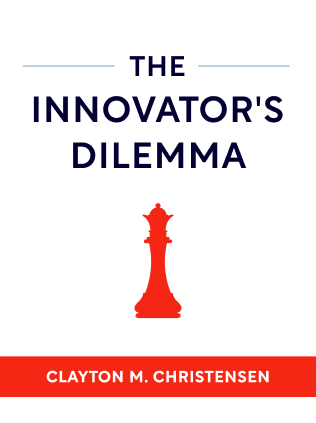

This article is an excerpt from the Shortform summary of "The Innovator's Dilemma" by Clayton M. Christensen. Shortform has the world's best summaries of books you should be reading.
Like this article? Sign up for a free trial here .
What are strategies for encouraging innovation? How are smaller markets beneficial for innovators?
Encouraging innovation is a complicated task. You need sufficient opportunities for selling your new product, but going too big too soon is also challenging.
Read more about encouraging innovation.
Small Markets Aren’t Encouraging Innovation by Big Companies
Companies typically get bigger the longer they’re in business. While growth equates to success under normal circumstances, it inhibits companies from transitioning to disruptive technologies.
As companies get larger, they need to bring in increasing profits to cover growing costs. The larger a company gets, the less it’s able to spend valuable resources on projects with low profit margins.
Problem: Pressure to Perpetually Grow Isn’t Encouraging Innovation
Most executives feel pressured to continue growing their companies for several reasons:
- The growth rate of a company’s earnings drives its stock prices, which makes investors happy, which puts the company in a good position to access capital. Additionally, employees who have stock options are incentivized to continue working hard when stock prices are growing.
- Growth helps keep top-performing employees in the company, because it creates room for them to move up to higher positions. If the company stagnates or struggles, it risks losing its best employees to other, more successful companies.
- Growing companies can justify investments in new technologies more easily than stagnated companies can.
However, perpetual growth creates a conundrum: The bigger a company gets, the harder it is to continue growing and it isn’t encouraging innvoation.
For example, if a $40 million company aims to maintain a 20 percent annual growth rate, the goal is much easier to attain in the early years—$8 million the first year, $9.6 million the next year—but the figure quickly climbs. The $8 million growth the company needed in the first year more than doubles by the fifth year and nearly triples by the seventh year. By the time the company is worth $400 million, it needs to bring in $80 million to maintain its growth rate.
The emerging markets for disruptive innovations are too small to support large companies’ growth needs. But if big companies wait until the disruptive technology’s market is established enough to better satisfy their growth needs, they miss the critical window for entry.
Pioneers of Disruptive Innovations Have an Advantage Over Late Adopters
When an innovation emerges in an industry, a company’s decision about whether to lead or follow the trend plays a critical role in its fate.
On one hand, pioneers can reap the rewards of first-mover advantages, which allow the company to build brand recognition and customer loyalty before other firms enter the market. First-mover advantages are encouraging innovation. On the other hand, followers can avoid costly missteps by waiting to enter a market until the pioneers have encountered and resolved early issues.
Research shows that companies that pioneer sustaining technology have no early learning advantage or any other substantial benefit over the companies that follow later.
However, companies that pioneer disruptive technology in emerging markets perform significantly better in the mid- to long-term than late adopters. For example, the first disk-drive companies to adopt thin-film technology averaged $1.9 billion in revenues during an 18-year period, while the late-adopting companies averaged only $64.5 million.
Late adopters delayed in order to minimize their market risk—entering an emerging market with an unproven technology—but the tradeoff was increasing their competitive risk—the threat of facing fierce competition if they entered the market later.
Solution: Create a Small, Independent Organization Responsible for Encouraging Innovation
When large established firms are confronted with this dilemma, they typically take one of three approaches:
- Try to push the emerging market to grow more quickly
- Wait until the market has grown
- Create independent entities to develop and market the disruptive technology, and make sure the entity is small enough to match the size of the market
As we’ll see in the following case studies, the first two strategies are seldom successful at encouraging innovation. By contrast, the third strategy is the most effective way for a company to tackle a disruptive project.
We talked in the last chapter about the benefits of an established firm creating an independent organization to lead disruptive projects. When a company creates the independent entities, it’s essential that its size fits the small (albeit unknown) market it’s targeting, because:
- Small companies are free of large companies’ high-profit growth obligations.
- Small entities can get excited about small opportunities and victories that would be considered disappointing in the context of a big company, and that enthusiasm is critical to driving motivation to push the project’s progression.
Assign Small Organizations to Small-Market Projects
When companies assign disruptive projects to small, independent organizations, they can take two approaches:
1) Create an entity or division within the parent company. Control Data Corporation (CDC) took this approach when the company developed its 5.25-inch drives.
CDC’s headquarters was in Minneapolis, but it created a team in Oklahoma City to commercialize the 5.25-inch products. This small organization could get excited about the small orders that were inevitable in the early years of the emerging desktop computer market. The spin-out organization was ultimately a success.
2) Acquire a small company. Allen Bradley Company (AB) went this route when it began producing disruptive electronic programmable motor controllers, which were used in factories that were beginning to automate operations.
AB was an established electromechanical control maker when the disruptive electronic controllers emerged. A year after the first electronic controller hit the market, AB bought two small companies specializing in programmable controllers. Then AB combined them into one organization, which remained separate from AB’s main business. As a result, AB was the only established firm to survive the disruption.

———End of Preview———
Like what you just read? Read the rest of the world's best summary of Clayton M. Christensen's "The Innovator's Dilemma" at Shortform .
Here's what you'll find in our full The Innovator's Dilemma summary :
- Christensen's famous theory of disruptive innovation
- Why incumbent companies often ignore the disruptive threat, then move too slowly once the threat becomes obvious
- How you can disrupt entire industries yourself






